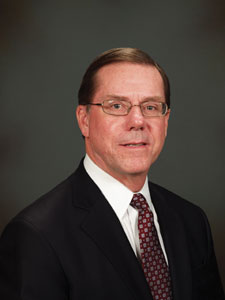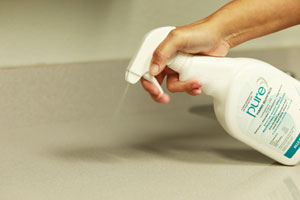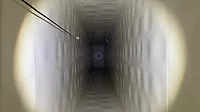Engineering R&D
Surface appeal: Novel antimicrobial for direct food contact
Novel antimicrobial quickly neutralizes broad range of pathogens on food contact surfaces; now takes aim at direct food contact.
 |
| Hank Lambert, CEO, PURE Bioscience Inc. Source: PURE Bioscience. |
Chlorine- and ammonia-based disinfectants and sanitizers are typically used as interventions or rinses to eliminate dangerous bacteria, fungi, viruses and foodborne pathogens on food preparation and food processing areas.
However, according to PURE Bioscience, a manufacturer of antimicrobial products, some germs have built up a resistance to many antimicrobials in use on food products today.
The company has created a unique antimicrobial based on silver dihydrogen citrate (SDC), a proprietary combination of stabilized ionic silver and citric acid. SDC is the latest newly patented antimicrobial for food contact surfaces registered with the US EPA in more than 30 years, according to PURE Bioscience.
Currently, the company offers SDC in a product for food contact surfaces, but it is developing a formulation for a new application: direct food contact. PURE Bioscience CEO Hank Lambert estimates the potential available US market for new and direct food contact antimicrobials to be in excess of $1 billion.
Lambert has more than 35 years of food industry experience, holding positions at R. J. Reynolds, Nabisco and Pinnacle Foods. Lambert earned his MBA in finance from the University of Chicago, Booth School of Business, and a bachelor’s degree in economics from Union College in Schenectady, NY.
FE: How is SDC different from competing disinfectants?
Lambert: Ammonia- and chlorine-based disinfectants and sanitizers used as interventions and rinses are formulated at relatively low concentrations for toxicity reasons, which impacts their efficacy in terms of pathogen kill. Antimicrobials have to kill certain types of germs within a defined window of time while keeping toxicity levels low—without negatively impacting the appearance, taste or quality of the food it is being used on. Many common [or old generation] ingredients used include alcohol, quaternary ammonium chlorines [quats] and bleach.
PURE Bioscience’s patented SDC antimicrobial kills germs in as little as 30 seconds (versus up to 10 minutes with competing solutions) and provides residual protection for 24 hours. SDC eliminates more than 31 harmful germs including Pseudomonas aeruginosa, Campylobacter jejuni, Staphylococcus aureus, Salmonella, MRSA, Listeria, noroviruses and E. coli, as well as H1N1, VRE, NDM-1-producing carbapenem-resistant Klebsiella pneumoniae, hepatitis B and C, HIV 1, influenza A, rhinoviruses, herpes simplex type 1, poliovirus type 2, human coronaviruses, rotavirus and avian influenza A.
SDC offers broad-spectrum protection as a disinfectant, fungicide and virucide. Traditional disinfectants do not have the same broad-spectrum antimicrobial activity.
In addition, EPA has assigned SDC the lowest toxicity category [category IV]. No hazard warnings are required on the label, and the product is generally regarded as safe [GRAS] as a contact biocide.
SDC is colorless, odorless, tasteless and EPA authorized for use as a disinfectant and sanitizer in food processing plants, food preparation areas and public eating areas, even when people are present. SDC does not irritate skin, is nonflammable and does not cause bacterial resistance. It is a natural, nontoxic antimicrobial that ensures the quality and safety of these cleaning products—without exposing humans or the environment to toxic chemical preservatives.
The product is a ready-to-use disinfectant that eliminates 99.999 percent of the bacteria, such as E. coli and Staphylococcus aureus, in 60 seconds or less.
 |
| SDC is a natural, nontoxic, nonflammable antimicrobial that kills more than 31 types of germs in as little as 30 seconds and provides up to 24 hours of ongoing protection. Source: PURE Bioscience. |
FE: Why is SDC a superior technology?
Lambert: Traditional silver-based disinfectants have a very short shelf life, ranging from hours to days, while SDC is a stabilized silver ion complex with a shelf life of several years. In SDC, the silver ion has a unique bond that allows it to remain in solution while making it more bioavailable for antimicrobial action. It is an electrolytically generated source of stabilized ionic silver that can serve as the basis for a wide range of products in diverse markets.
As a platform technology, SDC is distinguished from existing products by its superior efficacy, reduced toxicity and inability of bacteria to form a resistance to it. Also, there are no volatile organic compounds. When used as a contact surface sanitizer, it requires no rinsing afterward. It is a ready-to-use, non-corrosive disinfectant.
PURE Hard Surface is registered for use on food contact surfaces and is gentle enough to be used in childcare environments. Areas of application include food processing plants, food storage areas, supermarkets, kitchens, schools, hotels and dining halls. It can be applied on painted surfaces, plastic, metal, glass, glazed porcelain and glazed tile.
In fisheries or wine, citrus, potato or ice cream processing plants, it can be used as a sanitizer on conveyor belts and equipment to reduce or eliminate odors in the processing area. It is also suitable for use on filling equipment to reduce bacteria.
FE: What is the state of commercial development?
Lambert: PURE Hard Surface disinfectant and food contact surface sanitizer is a commercial product authorized for use only on food contact surfaces for food processing, food preparation and public eating places, but we have an initiative underway to develop a formulation that can be directly applied to food. In terms of chemical makeup, the SDC rinse or spray being developed for direct food contact will be very similar to PURE Hard Surface. The distinction will be in the dilution.
We are testing different dilutions to see which one yields the greatest impact as a direct rinse or processing aid on produce, poultry and meats. We initiated this project in December 2013 and have retained Dr. James Marsden, a food safety scientist and expert at Kansas State University, for the testing and preparation of the submissions for authorization to the FDA and USDA.
Active ingredients in the food surface contact antimicrobial include SDC at 0.003 percent, citric acid at 4.846 percent and other ingredients representing 95.151 percent.
FE: How does it work?
Lambert: SDC utilizes a two-pronged attack against microorganisms. The first is attracting the microorganism to the antimicrobial. The second step is denaturing or neutralizing the germs. The bacterial outer membrane is called the cell wall. Bacterial cell walls are made of peptidoglycan, which provides protection and rigidity to the organism. The exact membrane constitution depends on the type of bacteria.
The citric acid forms a shell around the SDC. Unlike traditional antimicrobials, bacteria are actually attracted to SDC because they recognize citric acid as a food source. SDC enters the microorganism as a “Trojan horse” through membrane transport proteins. As the organism dissolves the citric acid shell, it frees the SDC to target the organism’s cell wall.
Silver ions are highly attracted to sulfur-containing thiol groups in metabolic and structural proteins bound to the membrane surface. SDC targets those critical proteins in the bacteria, fungi or viruses and destroys the structure in an extracellular attack. Once inside the organism, SDC binds to the DNA and intracellular proteins, causing irreversible damage to the DNA and protein structure. SDC halts the microbe’s ability to replicate and disrupts its membrane function and integrity. Metabolic and reproductive functions halt, and the organism dies.
SDC also provides virucidal action. Viruses are much smaller than bacteria and fungi and do not have metabolic activity. Viruses present fewer target sites on which a biocide can act. Silver destroys the viral envelope or capsid, preventing the virus from attaching to a host cell, and destroys the infectious component of the virus, the nucleic acid.
FE: What are the current applications?
Lambert: We are completing the final stage of testing in a leading quick service restaurant chain. Third-party validated test results to date have consistently shown the use of PURE resulting in 90 percent greater effectiveness in the reduction of bacteria and food safety risk.
Following extensive plant testing of the product, we have received initial orders from four national food processors. The product continues to be tested at a number of other leading food processors where initial results have been very positive.
Looking for a reprint of this article?
From high-res PDFs to custom plaques, order your copy today!







